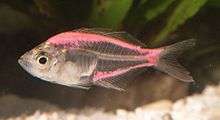Painted fish

The term painted fish refers to ornamental aquarium fish which have been artificially coloured to appeal to consumers. This artificial colouring, also known as juicing, is achieved by a number of methods, such as injecting the fish with a hypodermic syringe containing bright fluorescent colour dye, dipping the fish into a dye solution, or feeding the fish dyed food.
This process is usually done to make the fish a brighter colour and more attractive to consumers. The colouring of the fish is not permanent, and usually fades away in six to nine months.
Methods
There are a number of methods for introducing artificial colour to fish, although specific information on methodology is sometimes scanty.
Dyes
A common method of creating "painted fish" is through injection via syringe. Generally, fish are injected multiple times.[1] Fish may also be dipped in a caustic solution to strip their outer slime coat, then dipped in dye. This method is reported to have a very high mortality rate.[2]
Many varieties of "colour-enhancing" foods for aquarium fishes are available to the consumer. Generally, these foods contain natural dyes, such as beta carotene, and are not harmful to fish, although as with other dye methods, the effect is temporary. One source reports that harmful dyes are sometimes used by wholesalers, however.[2]
Lasers
Fish can also be tattooed using a low-intensity laser with a dye, a process developed for fisheries by scientists but this technique is now applied to ornamental fish.[3]
Genetic modification
Aquarium fish genetically modified to fluoresce in bright colours under white or ultraviolet light are now available commercially in the United States, under the trade name GloFish. The technology was developed originally to produce a fish capable of detecting environmental pollution.[4] These zebrafish are available in several fluorescent colours, protected by a United States patent.[5]
Hormones
It is not introducing any kind of artificial color, but provoking the apparition of mating period tonalities by administering hormones. This is argued to be used for minimizing the stressful effects of transport in fish aspect. This might also be used for making females of certain fish species look more colorful, despite this can also render them infertile.[6]
Varieties

Some species, such as albino Corydoras and "painted" glassfish, are injected with dye using a hypodermic needle. In more recent times (2004-2005), injection dyed albino Plecostomus and rift lake cichlids have also become available. Other than the Indian Glassy Fish, most dyed fish are albinos.
Some commonly painted species
- Indian Glassy Fish (Parambassis ranga). Tradename: Painted glassfish; Disco Fish; Colored Glass Tetra; Lightbulb tetra.
- Black tetra (Gymnocorymbus ternetzi). Tradenames: Berry Tetra; Painted Tetra.
- Oscar (Astronautus ocellatus). Tradenames: Blueberry Oscar; Strawberry Oscar.
- Corydoras species
- African Rift Lake cichlids, such as Pseudotropheus. Tradenames: Ice Blue Albino Cichlid; Zebra Ice Albino Cichlid.
- Suckermouth catfish (Hypostomus plecostomus). Tradenames: Patriotic Suckerfish; Mixed Color Suckerfish.
- Blood parrot cichlid (Amphiliphus citrinellus x Heros severus). Tradenames: Jellybean Cichlid; Cotton Candy Cichlid.
- Goldfish (Carassius auratus). Tradenames: Jellybeans; Icepops.[7]
Health hazards to painted fish
A 1998 survey carried out in the South of England revealed that over 40% of painted glassfish showed signs of a Lymphocystis infection, compared to 10% of unpainted glassfish. The infection may have been caused by transmitting the virus from fish to fish via an infected needle, or by a reduced resistance to the infection due to stress from the injection process.[1] In addition, fishes injected with dye often die without apparent external disease symptoms, presumably due to kidney disease caused by injection.[8]
Efforts to stop fish painting
Some members of the aquarium trade want to ban this practice. For example, the British publication Practical Fishkeeping started a campaign in 1996 to ask retailers to stop selling dyed fish, which led to a significant decrease in the number sold in the United Kingdom. Practical Fishkeeping has launched a similar campaign with a global scope and maintains a register of stores which do not stock dyed fish.[9] The Royal Society for the Prevention of Cruelty to Animals (RSPCA) regards the practice as cruel and unnecessary cosmetic mutilation. A campaign in Australia and in the UK has limited the sale of these fish. Dyed fish are still available and are generally imported from Southeast Asia.
In February 2006, the UK's Department for Environment, Food and Rural Affairs (Defra) confirmed that it would not be making it illegal to sell dyed fish in the UK under the Animal Welfare Bill.[10]
References
- 1 2 Dr Stan MacMahon and Dr Peter Burgess (March 1998). "Why it's cruel to dye". Practical Fishkeeping. Archived from the original on December 17, 2008. Retrieved April 20, 2009.
- 1 2 Shirlie Sharp. "Death by Dyeing". About.Com. Retrieved May 19, 2006.
- ↑ "Company offers custom fish tattoos with laser". Practical Fishkeeping. 2006-02-23. Archived from the original on 2006-04-11. Retrieved 2006-05-19.
- ↑ "GloFish: First Genetically Modified Pet in U.S.". The Pew Initiative on Food and Biotechnology. 2004. Retrieved 2006-12-10.
- ↑ "United States Patent 7,135,613". November 14, 2006. Retrieved 2006-12-10.
- ↑ http://www.thekrib.com/Fish/steroids.html thekrib.com
- ↑ "Shades of Death". Retrieved 2006-05-19.
- ↑ Jim Greenwood, B.V.Sc. "What's wrong with a painted angel?". Eastern Districts Aquarium Society. Archived from the original on December 8, 2007. Retrieved 2009-04-20.
- ↑ "Dyed Fish Campaign". Practical Fishkeeping. Archived from the original on 2006-02-14. Retrieved 2006-05-19.
- ↑ "Dyed fish to remain legal". Practical Fishkeeping. 2006-02-17. Archived from the original on 2006-03-03. Retrieved 2006-05-19.